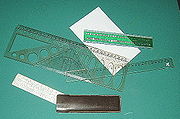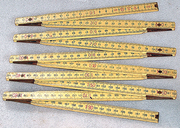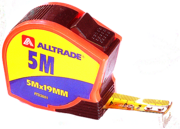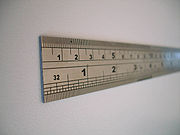
Ruler
Encyclopedia




Measuring instrument
In the physical sciences, quality assurance, and engineering, measurement is the activity of obtaining and comparing physical quantities of real-world objects and events. Established standard objects and events are used as units, and the process of measurement gives a number relating the item...
used in geometry
Geometry
Geometry arose as the field of knowledge dealing with spatial relationships. Geometry was one of the two fields of pre-modern mathematics, the other being the study of numbers ....
, technical drawing
Technical drawing
Technical drawing, also known as drafting or draughting, is the act and discipline of composing plans that visually communicate how something functions or has to be constructed.Drafting is the language of industry....
, printing
Printing
Printing is a process for reproducing text and image, typically with ink on paper using a printing press. It is often carried out as a large-scale industrial process, and is an essential part of publishing and transaction printing....
and engineering/building to measure distances and/or to rule straight lines. Strictly speaking, the ruler is essentially a straightedge
Straightedge
A straightedge is a tool with an edge free from curves, or straight, used for transcribing straight lines, or checking the straightness of lines...
used to rule lines, but typically the ruler also contains calibrated lines to measure distances.
Types
Rulers have long been made of wood in a wide range of sizes. They are not however all wooden. Plastics have been used since they were invented; they can be molded with length markings instead of being scribed. Metal is used for more durable rulers for use in the workshop; sometimes a metal edge is embedded into a wooden desk ruler to preserve the edge when used for straight-line cutting. 12 inches or 30 cm in length is useful for a ruler to be kept on a desk to help in drawing. Shorter rulers are convenient for keeping in a pocket. Longer rulers, e.g., 18 inches (45 cm) are necessary in some cases. Rigid wooden or plastic yardstickYardstick
A yardstick is a straightedge used to physically measure lengths of up to a yard high. Yardsticks are flat wooden boards with markings at regular intervals.-Construction:...
s, 1 yard long and meter sticks, 1 meter long, are also used. Classically, long measuring rod
Measuring rod
A measuring rod is a tool used to physically measure lengths and survey areas of various sizes. Most measuring rods are round or square sectioned, however they can be flat boards. Some have markings at regular intervals...
s were used for larger projects, now superseded by tape measure
Tape measure
A tape measure or measuring tape is a flexible form of ruler. It consists of a ribbon of cloth, plastic, fiber glass, or metal strip with linear-measurement markings. It is a common measuring tool. Its flexibility allows for a measure of great length to be easily carried in pocket or toolkit and...
or laser rangefinder
Rangefinder
A rangefinder is a device that measures distance from the observer to a target, for the purposes of surveying, determining focus in photography, or accurately aiming a weapon. Some devices use active methods to measure ; others measure distance using trigonometry...
s.
Desk rulers are used for three main purposes: to measure, to aid in drawing straight lines and as a straight guide for cutting and scoring with a blade. Practical rulers have distance markings along their edges.
A type of ruler used in the printing industry is called a line gauge. These may be made from a variety of materials, typically metal or clear plastic. Units of measurement on a basic line gauge usually include inches, agate, picas, and points
Point (typography)
In typography, a point is the smallest unit of measure, being a subdivision of the larger pica. It is commonly abbreviated as pt. The point has long been the usual unit for measuring font size and leading and other minute items on a printed page....
. More detailed line gauges may contain sample widths of lines, samples of common type in several point sizes, etc.
Measuring instruments similar in function to rulers are made portable by folding (carpenter's folding rule) or retracting into a coil (metal tape measure
Tape measure
A tape measure or measuring tape is a flexible form of ruler. It consists of a ribbon of cloth, plastic, fiber glass, or metal strip with linear-measurement markings. It is a common measuring tool. Its flexibility allows for a measure of great length to be easily carried in pocket or toolkit and...
) when not in use. When extended for use they are straight, like a ruler. The illustrations on this page show a 2-meter carpenter's rule which folds down to a length of 24 cm to easily fit in a pocket, and a 5-meter-long tape which retracts into a small housing.
A flexible length measuring instrument which is not necessarily straight in use is the tailor's fabric tape measure, a length of tape calibrated in inches and centimeters. It is used to measure around a solid body, e.g., a person's waist
Waist
The waist is the part of the abdomen between the rib cage and hips. On proportionate people, the waist is the narrowest part of the torso....
measurement, as well as linear measurement, e.g., inside leg. It is rolled up when not in use, taking up little space.
A contraction rule is made having larger divisions than standard measures to allow for shrinkage of a metal casting. They may also be known as a 'shrinkage or shrink rule.
Ruler applications in geometry
In geometry, a ruler without any marks on it (a straightedge) may be used only for drawing straight lines between points, not measuring. A straightedge is also used to help draw accurate graphs in algebra and other math subjects.A ruler and compass construction
Compass and straightedge
Compass-and-straightedge or ruler-and-compass construction is the construction of lengths, angles, and other geometric figures using only an idealized ruler and compass....
refers to constructions using an unmarked ruler and a compass. It is possible to bisect an angle into two equal parts with ruler and compass. It can be proved, though, that it is impossible to divide an angle into three equal parts using only a compass and straightedge — the problem of angle trisection
Angle trisection
Angle trisection is a classic problem of compass and straightedge constructions of ancient Greek mathematics. It concerns construction of an angle equal to one-third of a given arbitrary angle, using only two tools: an un-marked straightedge, and a compass....
. However, should two marks be allowed on the ruler, the problem becomes solvable.
History
Rulers made of IvoryIvory
Ivory is a term for dentine, which constitutes the bulk of the teeth and tusks of animals, when used as a material for art or manufacturing. Ivory has been important since ancient times for making a range of items, from ivory carvings to false teeth, fans, dominoes, joint tubes, piano keys and...
were in use by the Indus Valley Civilization
Indus Valley Civilization
The Indus Valley Civilization was a Bronze Age civilization that was located in the northwestern region of the Indian subcontinent, consisting of what is now mainly modern-day Pakistan and northwest India...
period prior to 1500 BC. Excavations at Lothal
Lothal
Lothal is one of the most prominent cities of the ancient Indus valley civilization. Located in Bhāl region of the modern state of Gujarāt and dating from 2400 BCE. Discovered in 1954, Lothal was excavated from February 13, 1955 to May 19, 1960 by the Archaeological Survey of India...
(2400 BC) have yielded one such ruler calibrated to about 1/16 in. Ian Whitelaw holds that the Mohenjo-Daro
Mohenjo-daro
Mohenjo-daro is an archeological site situated in what is now the province of Sindh, Pakistan. Built around 2600 BC, it was one of the largest settlements of the ancient Indus Valley Civilization, and one of the world's earliest major urban settlements, existing at the same time as the...
ruler is divided into units corresponding to 1.32 in (33.5 mm) and these are marked out in decimal subdivisions with amazing accuracy, to within 0.005 in (0.127 mm). Ancient bricks found throughout the region have dimensions that correspond to these units.
Anton Ullrich
Anton Ullrich
Johannes Anton Ullrich was a German industrialist, inventor, and co-founder of the "Gebrüder Ullrich" in the Rhineland-Palatinate.-Life:...
invented the folding ruler in 1851.
Philosophy
Ludwig WittgensteinLudwig Wittgenstein
Ludwig Josef Johann Wittgenstein was an Austrian philosopher who worked primarily in logic, the philosophy of mathematics, the philosophy of mind, and the philosophy of language. He was professor in philosophy at the University of Cambridge from 1939 until 1947...
famously used rulers as an example in his discussion of language games
Language-game
A language-game is a philosophical concept developed by Ludwig Wittgenstein, referring to simple examples of language use and the actions into which the language is woven.- Description :...
in the Philosophical Investigations
Philosophical Investigations
Philosophical Investigations is, along with the Tractatus Logico-Philosophicus, one of the most influential works by the 20th-century philosopher Ludwig Wittgenstein...
. Wittgenstein pointed out that standard meter bar in Paris was the criterion against which all other rulers were determined to be one meter long, but that there was no analytical way to demonstrate that the standard meter bar itself was one meter long. It could only be asserted as one meter as part of a language game.
See also
- Dividing engineDividing engineA dividing engine is a device specifically employed to mark graduations on measuring instruments.-History:There has always been a need for accurate measuring instruments...
- Geometry templateGeometry templateA geometry template is a piece of clear plastic with cut-out shapes for use in mathematics and other subjects in primary school through secondary school. It functions as a stencil, protractor, ruler, French curve and straightedge. It can also be called a mathomat....
- Golomb rulerGolomb rulerIn mathematics, a Golomb ruler is a set of marks at integer positions along an imaginary ruler such that no two pairs of marks are the same distance apart. The number of marks on the ruler is its order, and the largest distance between two of its marks is its length...
- Measuring rodMeasuring rodA measuring rod is a tool used to physically measure lengths and survey areas of various sizes. Most measuring rods are round or square sectioned, however they can be flat boards. Some have markings at regular intervals...
- Rolling rulerRolling rulerA rolling ruler is a ruler that contains a cylinder much like a rolling pin inside, thereby enabling it to "roll" along a sheet of paper or other surface where it is being used. A rolling ruler can draw straight, parallel lines, and also has other instruments included, enabling it to do the jobs of...
- Scale rulers: architect's scaleArchitect's scaleAn architect's scale is a specialized ruler designed to facilitate the drafting and measuring of architectural drawings, such as floor plans and orthographic projections...
and engineer's scaleEngineer's scaleAn engineer's scale is a tool for measuring distances and transferring measurements at a fixed ratio of length. It is commonly made of plastic,or aluminum and is just over long, but with only 12 inches of markings, leaving the ends unmarked so that the first and last measuring ticks do not...

